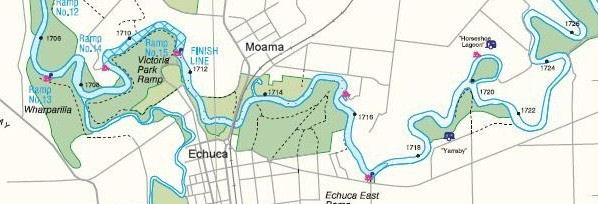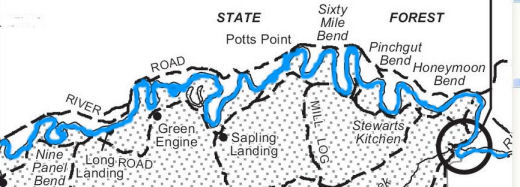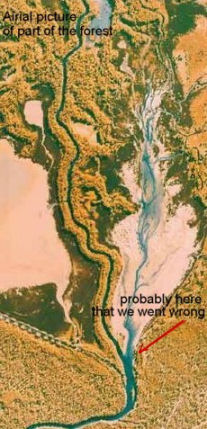My interest in sailing was temporally diverted to power boats. I had designed a range of power boats, mainly because we had just been granted a dealership for Mercury outboards. Up to this time most big outboards had been imported by individuals direct from the USA, but now a distributor had been set up in Australia, and we were lucky to be one of the five retailers appointed in Victoria at that time.
This amounted to a big outlay as we were expected to stock a full representative range, (at that time eight different models) so it was decided that we would need to build power boats from twelve up to eighteen feet to accommodate the range of motors, and to help promote our new products. We were going to participate in suitable events that would help show them off, and when the inaugural Murray River Marathon event for power boats was announced we jumped at the chance to compete.
Race weekend, and the day before the race we were lined up at the boat ramp just up stream of Echuca along with about thirty other competitors, who mainly consisted of builders of runabouts, and outboard motor dealers, along with members of racing boat clubs mostly from Victoria.
There was some commotion when a member of the New South Wales Marine board appeared and asked what we were up to, and what were we doing on a New South Wales river without a NSW power boat drivers licence. Someone asked, “What was he talking about?” Here we are in Victoria, and there are no licence requirements anyway. The gentleman then explained that the Murray River was a NSW river, and it even controlled the land one chain’s width from the bank all along the Victorian side, so if we wanted to use the river, we would have to have a NSW licence, otherwise stay off the river. The inspectors had heard of the race, and had come down from Sydney to issue licences to anyone who was prepared to go up to the Moama court house and sit for the examination. Otherwise stay off the river!!!
We were herded over to the Moama court house and asked to pay the licence application fee, and if I remember correctly that was five pounds, and that was a lot of money in the 1960s. We were handed an examination paper, and asked to complete the list of questions, most of which had little relation to our run on the river. One question that I remember related to the signals displayed by a “Tug with a tow” on Sydney Harbour. In spite of the irrelevant questions, it appeared that everyone had passed, even though most admitted that they couldn’t answer half the questions.
For two men to come down from Sydney, and stay the weekend, all for maybe one hundred and fifty pounds, just to license thirty boat drivers who couldn’t possibly have passed their exams. What was the point?

The race starting and finishing line was Echuca.
The course for day one was from Echuca down stream to Torrumbarry weir and return to Echuca approximately 240 statute miles. (by water)
Day two from Echuca upstream to a point beyond the Barmah forest and return approx 245 miles.
On race day a strange combination of boats faced the starters gun. There were little three pointers with the largest outboards available. There were several of the newly built fibreglass bare hulls fitted with only a dashboard, motor well, and a timber thwart, and sporting two big outboards. Tom Wesson had specially built an “Air boat” with a small aircraft engine driving a pusher propeller, and, the at the time popular plywood runabouts, also our fourteen foot moulded plywood runabout.
Right from the start the new fibreglass hulls with dual outboards (a very new innovation at the time) cleared out from the rest, and we were left with the back half of the fleet, mainly production built runabouts, but it wasn’t long before one of the bigger boats came in to view. It had run into the bank of the river with what seemed to be a steering problem. The Air boat was fast, but having a lot of trouble on the many bends in the river. It tended to spin out on the sharp turns and had no control at all when it was throttled back. Several boats were in trouble with outboard motors and it was strange hearing the fast boats only a short distance across on the big loops of the river, but really several miles ahead.
The run down to the Torrumbarry weir, our turning and refuelling point, took over three hours. We had started to run into the faster boats on the return run ten minutes before we had even arrived.
It was chaos with the main batch of boats arriving at the same time and trying to refuel. There was a stack of empty drums on the bank, and just as we pulled in, the Air boat having refuelled took off at full throttle, and empty drums flew in all directions adding to the confusion.
I had promised my co-driver, one of our very enthusiastic apprentices, his turn to drive on the way back, and it was quite a relief to be able to move around a little after the long run to Torrumbarry.
Years earlier I had half hatched a plan to try and sail down the Murray from Echuca to the entrance, but just after a few hours in a power boat, realized what a hopeless effort that would be. There was no wind at all most of the way, as the high banks sheltered the water until you came to a bend, and then there was a blast from dead ahead. I also found the river very boring. There was little to see, just high muddy banks, and the fact that after travelling miles along the river you found yourself within a short distance across to where you had been ten minutes ago.
A half dozen or so boats had dropped out by the time we arrived back at Echuca, and we were in around twentieth which wasn’t too bad considering we had only about 20% of the power of some of the boats.
Day two, and the course was to take us upstream and through the extensive Barmah forest. We were advised to take particular care with navigation, as there were many channels leading off the main river.

The river within the Barmah forest is an incredible tangle of twists and loops
and you have the feeling of going around in circles and getting nowhere.
How do you navigate a river? There were so many loops, turns, and twists that it was difficult to keep a check on your location at any one time.
After about an hour, and well into forest, we came to a reasonably straight and wide section of the river and we assumed it was safe to continue straight ahead. On the map we knew that there was a point where we had to veer off to the left to keep in the main river, but we must have missed it because of the trees along the banks. We tried the wrong left turn which ended nowhere. When we came back to the wide section again we assumed that the turn was further on. And it was here that we became hopelessly lost.
It took some time to find a way out, and back in to the main channel. By this time we were well out of the race and our fuel reserve was becoming a concern.
On the way back to Echuca we came across another competitor being towed. It was one of the big stripped-out boats with big dual motors and his was a rather strange story.

This must have been where we went wrong
and kept going instead of taking the left fork.
About an hour into the race he had been in the lead, but then had run over a big snag and damaged the propeller on one of his motors, so his co driver had lifted the motor out, and onto a thwart at the stern of the boat while they were still racing. He was sitting on the floor changing to a spare propeller when the boat hit another log. The motor slid off the thwart and injured his leg. The outboard had been accidentally left locked down.
The impact had broken the lower gear case of the motor off, and it was lost on the bottom of the river. No thought was given to salvage it as it was more important was to get his mate back to some medical help. Another competitor behind them had seen the trouble they were in and pulled out of the race to tow them back to Echuca.
I had known the injured man, and a week later enquired as to how he was getting on. He said he was fine now, but his mate, the owner of the boat, had found out the high cost of replacing the foot of his motor and had decided to go back that next weekend and try to find the lost section, and at least save the cost of the lower gear case section, and find it he did, but when he brought it back to the workshop it didn’t fit. It turned out to be from a different motor.
I had lost all interest in the Murray River and the marathon race. Less than half of the competitors in the inaugural race had finished and I decided sailing was a lot more fun, but my apprentice and co driver was as keen as ever, so we decided to enter again next year. He could take it on with another one of the boys.
We had been experimenting with foils and they had proved very efficient giving us a 15% better performance than a normal planing hull and in the flat water on the river should have given them a good chance of winning.
The newspaper clip tells the story of our entry that year. The river level was even lower, and the race was a complete disaster.
I don’t remember the race ever being held again.